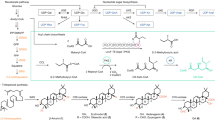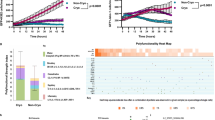Abstract
We have expressed a synthetic recombinant human TNF–β(rhTNF–β) gene in Escherichia coli to give rhTNF–β in a soluble, highly active and intact form. The specific activity of rhTNF–β purified in a single, convenient step from bacterial lysates was 3–5 × 107 units/mg on mouse L–929 cells. The cytostatic (growth inhibitory) and cytotoxic (cell killing) activities of rhTNF–β were compared in a variety of untransformed and transformed cell lines. In the absence of the protein synthesis inhibitor cycloheximide, two cell lines were growth inhibited by rhTNF–β but none were lysed. In the presence of cycloheximide, five out of eleven cell lines became sensitive to lysis by rhTNF–β, indicating that some but not all cells require uninterrupted protein synthesis in order to protect themselves from TNF–β cytotoxicity. Cell lines varied greatly in their sensitivity to rhTNF–β and a different pattern of response was seen in the cytostatic and cytotoxic assays.
This is a preview of subscription content, access via your institution
Access options
Subscribe to this journal
Receive 12 print issues and online access
$209.00 per year
only $17.42 per issue
Buy this article
- Purchase on Springer Link
- Instant access to full article PDF
Prices may be subject to local taxes which are calculated during checkout
Similar content being viewed by others
References
Paul, N.L. and Ruddle, N.H. 1988. Lymphotoxin. Ann. Rev. Immunol. 6:407–438.
Goeddel, D.V., Aggarwal, B.B., Gray, P.W., Leung, D.W., Nedwin, G.E., Palladino, M.A., Patton, J.S., Pennica, D., Shepard, H.M., Sugarman, B.J. and Wong, G.H.W. 1986. Tumour necrosis factors: gene structure and biological activities. Cold Spring Harbor Symp. Quant. Biol. 51:597–609.
Fiers, W., Brouckaert, P., Devos, R., Fransen, L., Leroux-Roels, G., Remaut, E., Suffys, P., Tavernier, P. Van der Heyden, J. and Van Roy, F. 1986. Lymphokines and monokines in anti-cancer therapy. Cold Spring Harbor Symp. Quant. Biol. 51:587–595.
Sugarman, B.J., Aggarwal, B.B., Hass, P.E., Figari, I.S., Palladino, M.A. and Shepard, H.M. 1985. Recombinant human tumor necrosis factor-α: Effects on proliferation of normal and transformed cells in vitro. Science 230:943–945.
Wang, A.M., Creasey, A.A., Ladner, M.B., Lin, L.S., Strickler, J., Van Arsdell, J.N., Yamamoto, R. and Mark, D.F. 1985. Molecular cloning of the complementary DNA for human tumor necrosis factor. Science 228:149–154.
Fransen, L., Ruysschaert, M.-R. Van der Heyden, J., and Fiers, W. 1986. Recombinant tumor necrosis factor: species specificity for a variety of human and murine transformed cell lines. Cell. Immunol. 100:260–267.
Mukavitz Kramer, S., Aggarwal, B.B., Eessalu, T.E., McCabe, S.M., Ferraiolo, B.L., Figari, I.S. and Palladino, M.A. 1988. Characterization of the in vitro and in vivo species preference of human and murine tumor necrosis factor-α. Cancer Res. 48:920–925.
Beutler, B., Mahoney, J., Le Trang, N., Pekala, P. and Cerami, A. 1985. Purification of cachectin, a lipoprotein lipase-suppressing hormone secreted by endotoxin-induced Raw 264.7 cells. J. Exp. Med. 161:984–995.
Torti, F.M., Dieckman, B., Beutler, B., Cerami, A. and Ringold, G.M. 1985. A macrophage factor inhibits adipocyte gene expression: an in vitro model of cachexia. Science 229:867–869.
Beutler, B., Milsark, I.W. and Cerami, A.C. 1985. Passive immunization against cachectin/tumor necrosis factor protects mice from lethal effect of endotoxin. Science 229:869–871.
Collins, T., Lapierre, L.A., Fiers, W., Strominger, J.L. and Pober, J.S. 1986. Recombinant human tumor necrosis factor increases mRNA levels and surface expression of HLA-A, B antigens in vascular endothelial cells and dermal fibroblasts in vitro. Proc. Natl. Acad. Sci. USA 83:446–450.
Pujol-Borrell, R., Todd, I., Doshi, M., Bottazzo, G.F., Sutton, R., Gray, D., Adolf, G.R., and Feldmann, M. 1987. HLA class II induction in human islet cells by interferon-γ plus tumour necrosis factor or lymphotoxin. Nature 326:304–306.
Aderka, D., Novick, D., Hahn, T., Fischer, D.G. and Wallach, D. 1985. Increase in vulnerability to lymphotoxin in cells infected by vesicular stomatitis virus and its further augmentation by interferon. Cell. Immunol. 92:918–925.
Esparza, I., Mannel, D., Ruppel, A., Falk, W. and Krammer, P.H. 1987. Interferon-γ and lymphotoxin act synergistically to induce macrophage killing of tumor cells and schistosomula of schistosoma mansoni. J. Exp. Med. 166:589–594.
Le, J. and Vilcek, J. 1987. Biology of disease—Tumor necrosis factor and interleukin 1: cytokines with multiple overlapping biological activities. Lab. Invest. 56:234–248.
Munker, R., Gasson, J., Ogawa, M. and Koeffler, H.P. 1986. Recombinant human TNF induces production of granulocyte-monocyte colony-stimulating factor. Nature 323:79–82.
Vogel, S.N., Douches, S.D., Kaufman, E.N. and Neta, R. 1987. Induction of colony stimulating factor in vivo by recombinant interleukin 1α and recombinant tumor necrosis factor α. J. Immunol. 138:2143–2148.
Beutler, B. and Cerami, A. 1988. Tumor necrosis, cachexia, shock and inflammation: a common mediator. Ann. Rev. Biochem. 57:505–518.
Nedwin, G.E., Naylor, S.L., Sakaguchi, A.Y., Smith, D., Jarrett-Nedwin, J., Pennica, D., Goeddel, D.V. and Gray, P.W. 1985. Human lymphotoxin and tumor necrosis factor genes: structure, homology and chromosomal localization. Nucleic Acids Res. 13:6361–6373.
Aggarwal, B.B., Eessalu, T.E. and Hass, P.I. 1985. Characterization of receptors for human tumor necrosis factor and their regulation by γ-interferon. Nature 318:665–667.
Decker, T., Lohmann-Matthes, M.-L. and Gifford, G.E. 1987. Cell-associated tumor necrosis factor (TNF) as a killing mechanism of activated cytotoxic macrophages. J. Immunol. 138:957–962.
Kriegler, M., Perez, C., DeFay, K., Albert, I., and Lu, S.D. 1988. A novel form of TNF/cachectin is a cell surface cytotoxic transmembrane protein: ramifications for the complex physiology of TNF. Cell 53:45–53.
Rothstein, J.L. and Schreiber, H. 1988. Synergy between tumor necrosis factor and bacterial products causes hemorrhagic necrosis and lethal shock in normal mice. Proc. Natl. Acad. Sci. USA 85:607–611.
Gray, P.W., Aggarwal, B.B., Benton, C.V., Bringman, T.S., Henzel, W.J., Jarrett, J.A., Leung, D.W., Moffat, B., Ng, P., Svedersky, L.P., Palladino, M.A. and Nedwin, G.E. 1984. Cloning and expression of cDNA for human lymphotoxin, a lymphokine with tumour necrosis factor activity. Nature 312:721–724.
Iserentant, D. and Fiers, W. 1980. Secondary structure of mRNA and efficiency of translation initiation. Gene 9:1–12.
Hall, M.N., Gabay, J., Débarbouilté, M. and Schwartz, M. 1982. A role for mRNA secondary structure in the control of translation initiation. Nature 295:616–618.
Porter, A.G., Bell, L.D., Adair, J., Catlin, G.H., Clarke, J., Davies, J.A. et al. 1986. Novel, modified β-interferons: gene cloning, expression and biological activity in bacterial extracts. DNA 5:137–148.
Sancar, A., Hack, A.M. and Rupp, W.D. 1979. Simple method for the identification of plasmid-encoded proteins. J. Bacteriol. 137:692–693.
Schein, C.H. and Noteborn, M.H.M. 1988. Formation of soluble recombinant proteins in Eschenchia coli is favored by lower growth temperature. Bio/Technology 6:291–294.
Mark, D.F., Lu, S.D., Creasey, A.A., Yamamoto, R. and Lin, L.S. 1984. Site-specific mutagenesis of the human fibroblast interferon gene. Proc. Natl. Acad. Sci. USA 81:5662–5666.
Aggarwal, B.B., Moffat, B. and Harkins, R.N. 1984. Human lymphotoxin-production by a lymphoblastoid cell line, purification and initial characterization. J. Biol. Chem. 259:686–691.
Aggarwal, B.B., Kohr, W.J., Hass, P.E., Moffat, B., Spencer, S.A., Henzel, W.J., Bringman, T.S., Nedwin, G.E., Goeddel, D.V. and Harkins, R.N. 1985. Human tumor necrosis factor: production, purification and characterization. J. Biol. Chem. 260:2345–2354.
Ruggiero, V., Latham, K. and Baglioni, C. 1987. Cytostatic and cytotoxic activity of tumor necrosis factor on human cancer cells. J. Immunol. 138:2711–2717.
Kirstein, M. and Baglioni, C. 1986. Tumor necrosis factor induces the synthesis of two proteins in human fibroblasts. J. Biol. Chem. 261:9565–9567.
Defilippi, P., Poupart, P., Tavernier, J., Fiers, W. and Content, J. 1987. Induction and regulation of mRNA encoding 26-kDa protein in human cell lines treated with recombinant human tumor necrosis factor. Proc. Natl. Acad. Sci. USA 84:4557–4561.
Hudziak, R.M., Lewis, G.D., Shalaby, M.R., Eessalu, T.E., Aggarwal, B.B., Ullrich, A. and Shepard, H.M. 1988. Amplified expression of the HER2/ERBB2 oncogene induces resistance to tumor necrosis factor α in NIH 3T3 cells. Proc. Natl. Acad. Sci. USA 85:5102–5106.
Spriggs, D., Imamura, K., Rodriguez, C., Horiguchi, J. and Kufe, D.W. 1987. Induction of tumor necrosis factor expression and resistance in a human breast tumor cell line. Proc. Natl. Acad. Sci. USA 84:6563–6566.
Tacon, W.C.A., Bonass, W.A., Jenkins, B. and Emtage, J.S. 1983. Expression plasmid vectors containing Escherichia coli tryptophan promoter transcriptional units lacking the attenuator. Gene 23:255–265.
Ray, A. and Skurray, R. 1983. Cloning and polypeptide analysis of the leading region in F plasmid DNA transfer. Plasmid 9:262–272.
Author information
Authors and Affiliations
Rights and permissions
About this article
Cite this article
Seow, HF., Goh, C., Krishnan, L. et al. Bacterial Expression, Facile Purification and Properties of Recombinant Human Lymphotoxin (Tumor Necrosis Factor Beta). Nat Biotechnol 7, 363–368 (1989). https://doi.org/10.1038/nbt0489-363
Received:
Accepted:
Issue Date:
DOI: https://doi.org/10.1038/nbt0489-363



